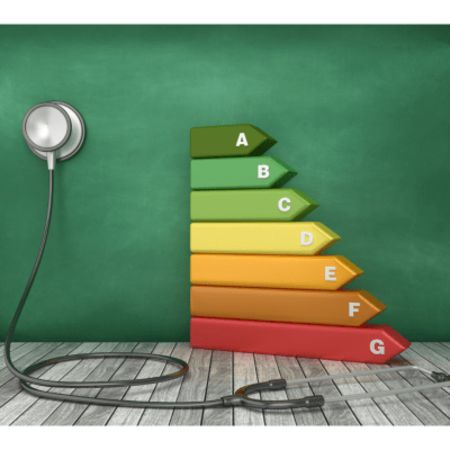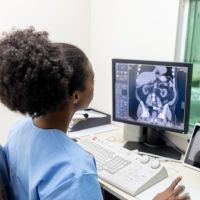Healthcare contributes substantially to the overall greenhouse gas emissions. Among all specialities, radiology is one of the most energy-intensive despite the industry's efforts to provide lower-consumption devices. Furthermore, contrast media residuals in wastewater and medical waste in interventional radiology contribute to radiology's environmental footprint. In this session chaired by Andrea Grace Rockall (UK), speakers provided an overview of radiology's impact in those areas and discussed new approaches to mitigate them.
Paving the way towards lower energy consumption
Tobias Heye (Switzerland) had a clear and actionable message: identify non-productive energy consumption factors, and turn them off. Before going in details about his experience at the Basel University Hospital, Pr Heye offered some much needed reminder about definitions of scanner activity system states. The system-on phase is defined by the scanner’s immediate availability to start scanning and is made up of three different time periods.
Net scan is the actual scan event, the productive phase when images are acquired.
Active phase represents the patient room time period during which a scanner is used to examine a patient.
Idle phase is the time interval between "active" time periods within system-on time period.
Careful monitoring revealed that two thirds of CT energy consumption came from idle time periods, underlining a clear potential for energy savings if the system is powered off when not in use.
Other imaging modalities offer similar usage profiles, with 33% of MRI energy consumption during off phase, and 80% of angiography system’s energy consumption during non-productive phase.
During idle phase, modalities operate at full speed and are ready to scan, leading to an high idle energy consumption. Easy to implement solutions would be to tighten schedule, shutdown the systems during lunch break or at end of programme. Start/stop technology, similar to cars, and MRI eco power modes could also be leveraged. Common barriers to energy consumption reduction are some myths and uncertainties within the user base. Education efforts should aim at dispelling these myths: No, regulary turning off modalities, especially MRI, does not break them. No, energy consumption is not increased when startups/shutdowns are more frequent. And finally, most devices startup quickly, no need for systems to be constantly on for emergencies.
Aside from modalities, printers, computers and virtual machines consume also a lot of energy, and in Basel a mere 10% of increased shutdown/standby mode led to 108’000kWh saved in a year, which amounts to more than 15 tons CO2 not released in the atmosphere, and 30’000€ in department savings.
Cooling demand in radiology departments consumes a lot of energy, and building HVAC systems are often oversized, due to devices manufacturers very large safety margins. In Basel, according to vendors’ specifications, cooling demand was sized at 480 kW, but real-life measures put an average at 160 kW. Also, HVAC do not always turn off when the machine in off, leading to cooling systems still active during off-hours and weekends.
In Basel University Hospital, leaving all systems and computers powered on 24/7 would use 500’000 kWh per year (priced at 125’250€), while systematic shutdown during off-hours would decrease consumption to only 200’000 kWh, priced at 50’375€. Savings potential is vast and solution easy to implement.
Contrast Media Recycling: Where Are We?
Olivier Clément (France) outlined in his lecture that use of iodinated contrast media(ICM) is increasing, parallel to the uptake of CT procedures in the world. Each year, 300 millions CT scans are performed, 40% using 100ml of ICM on average, putting total consumption at 12 million litres of ICM. The environmental challenge is certain, as contrast media ultimately ends up in the sewers systems, causing a pollution in surface water bodies and drinking water. Gadolinium contrast media poses the same sustainability challenges, especially as mining resources can be subject to supply chain issues and geopolitical troubles.
The first lever to mitigate this high level of consumption is optimizing the use of contrast media, by ensuring appropriate dosing tailored to the individual patient. Decreasing kV could also increase iodine detection. Finally, appropriate AI tools could be used to obtain valuable images with less CM.
A second opportunity lays in the recycling of contrast media, with various company initiatives being available, both for iodine and gadolinium. End of vials, unused vials and waste from contrast factories can be recycled and repurposed. Iodine for example, when it’s not usable anymore in the radiology department, can be reused for polarizing film production, disinfectants, catalysts or even table salt. Recycled gadolinium can be repurposed in lamps, X ray scintillators, nuclear power plant shielding…
Finally, waste from the patients can be collected after the CT with a longer hospital stay, and then properly recycled. This would yield the best results for contrast media sustainability.
Waste management in interventional radiology: can we do better?
Mark Burgmans (Netherlands) underlined the role radiology management teams can play in sustainability. Refurbished systems are a viable and qualitative option that should be considered when acquiring new equipment.
Disposables are also in scope, as they are the second highest source of greenhouse gas emissions in the IR department. Extensive and excessive packaging, as well as unused set components, represents unneeded waste that could be reduced by engaging with suppliers to re-design procedure packs according to local preferences and needs. By purchasing products only from manufacturers who have strict green policies and are committed to recycling and reusing their products and making sustainability part of tenders, radiology can become part of the sustainability solution. Radiology professionals themselves can have tremendous direct impact, by double checking materials before opening packaging, by setting up incentives to use soon to expire materials first. Systematically using alcohol instead of soap and water for hand hygiene would save more than 18 litres per washing. Finally, switching to reusable gowns and inflation devices could lead to thousands of tons of waste to be avoided, along with a substantial economic impact on department budgets.
There are plenty of opportunities to make radiology practices more sustainable:
- Take responsibility
- Install a green team
- Measure your energy consumption
- Switch off / to sleep mode when systems are not in use
- Reduce / Reuse / Recycle disposables
- Learn from others
Image Credit: iStock



























